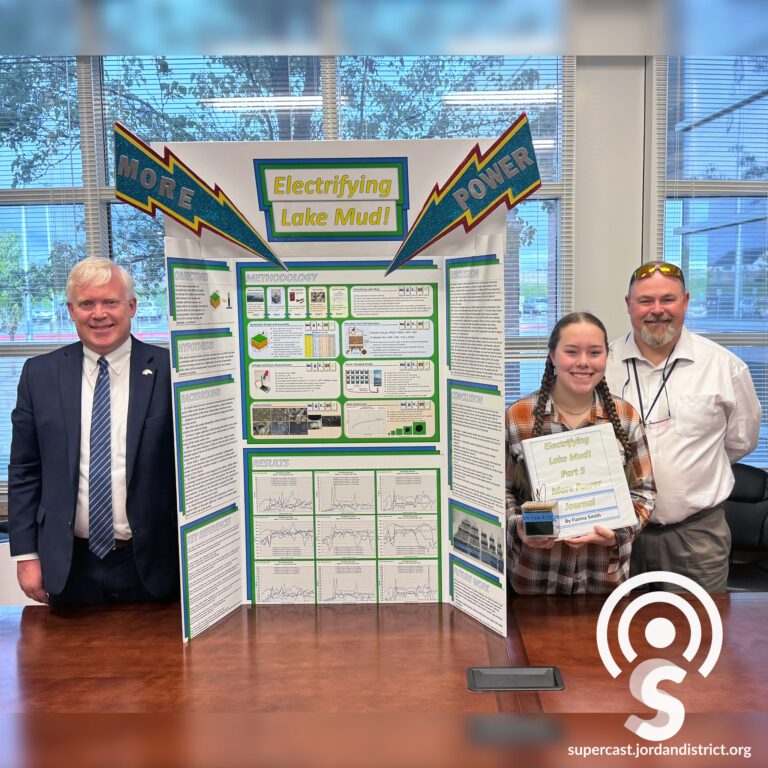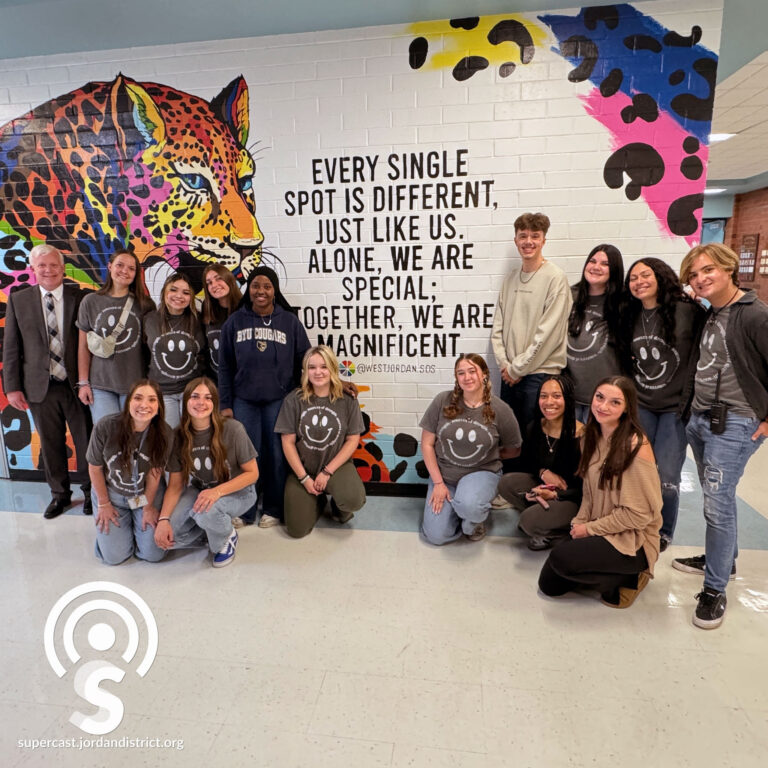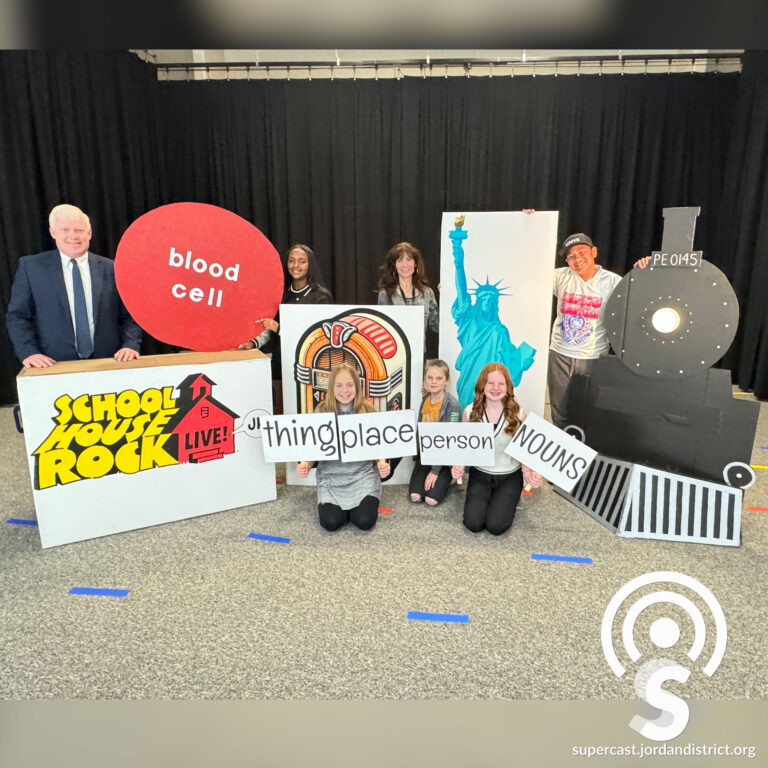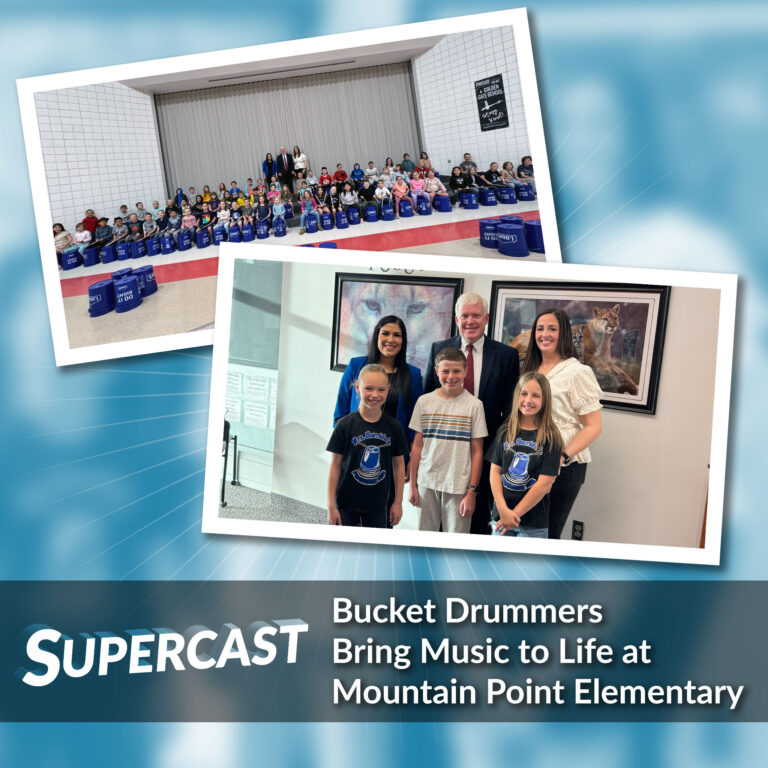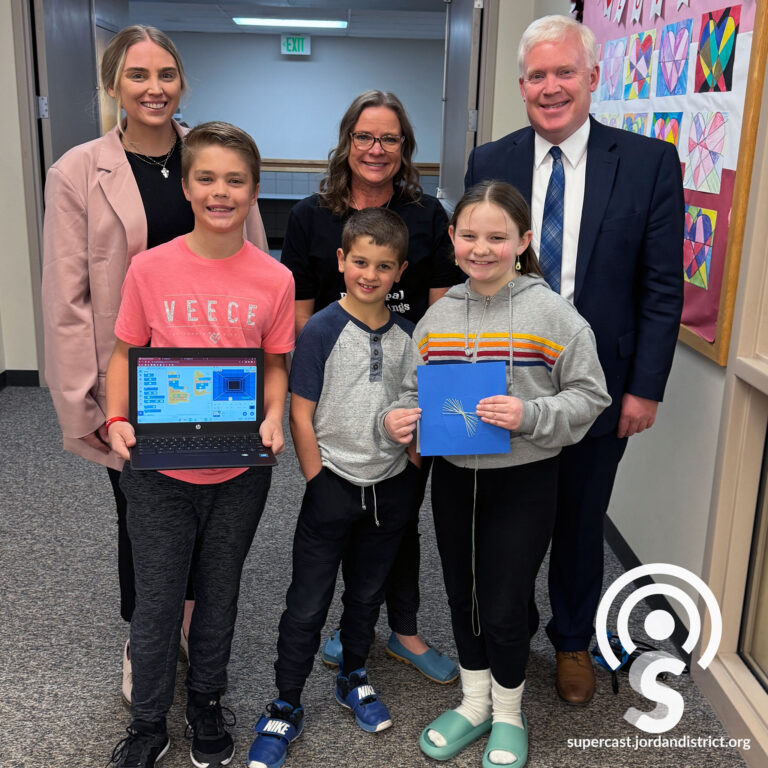She is an impressive young student scientist who has discovered an unlikely and very unusual source of electricity, using mud to power her iPhone and more.
On this episode of the Supercast, meet Herriman High School’s Fianna Smith whose discovery earned her a ticket to compete in a very prestigious and tough International STEM Fair. Fianna will pitch her science project to judges, going up against students from all over the world.
Audio Transcription
[Music]Anthony Godfrey:
Hello and welcome to the Supercast. I'm your host, Superintendent Anthony Godfrey. She is an impressive young student scientist who has discovered an unlikely and very unusual source of electricity using mud to power her iPhone and more.
On this episode of the Supercast, meet Herriman High School's Fianna Smith, whose discovery earned her a ticket to compete in a very prestigious and tough International STEM fair. Fianna will pitch her science project to judges, going up against students from all over the world.
[Music]We're talking with Fianna Smith at Herriman High School this morning about her science fair project. Thanks very much for taking the time to talk with me.
Fianna Smith:
Yeah, of course.
Anthony Godfrey:
You have competed at various levels and are now headed to the International Science and Engineering Fair. Is that correct?
Fianna Smith:
Yes.
Anthony Godfrey:
Tell me about the competition this year to this point.
Fianna Smith:
I have competed in– so there's two levels that I have to go through before I get to the International Science and Engineering Fair. And so that's Regionals and CUSF. CUSF is the Central Utah STEM Fair.
Anthony Godfrey;
And BYU is a sponsor of this and is connected to this, is that right?
Fianna Smith:
Yes.
Anthony Godfrey:
Okay, so tell me about the competition there. What were your awards there? I know that there were multiple.
Fianna Smith:
Yeah. I got like six special awards. One of them was the Stockholm Junior Water Prize, Regional Water Prize Award. And that is an entry, like that allows me to enter another competition that could potentially end up giving me a free trip to the Stockholm Water Plant in Sweden, along with a cash prize.
Anthony Godfrey:
That's fantastic. What were some of the other prizes that you won as well?
Fianna Smith:
I also got first place.
Anthony Godfrey:
Okay.
Fianna Smith:
And Grand Champion. Grand Champion is the award that allows me to go to ISEF. It's my ticket.
Anthony Godfrey:
It's your ticket to the International Fair. Now Grand Champion is a pretty big title for a teenager. I've never been a Grand Champion. I don't expect to be. But first place Grand Champion and the Water Prize and several others. How does that feel?
Fianna Smith:
It feels great. I feel very proud of myself for putting in all this work to get here.
Anthony Godfrey:
And you've been working on this for a long time. Tell me how long you've been working on this project. From the very start, from the very inception.
Fianna Smith:
I am a junior now and I have been working on this project since seventh grade.
Anthony Godfrey:
Wow.
Fianna Smith:
And I've won Grand Champion with this project every year. Except for as soon as I started ninth grade, that Grand Champion award was able to take me to the International Science and Engineering Fair.
Anthony Godfrey:
So not only are you a Grand Champion, you're just a Grand Champion on an annual basis basically at this point.
Fianna Smith:
Yeah.
Anthony Godfrey:
That's fantastic. I know it takes a lot of work to get there. Now you're going to the International Science and Engineering Fair. You've been there before.
Fianna Smith:
Yeah, I have.
Anthony Godfrey:
Tell me about that experience in the past.
Fianna Smith:
It is honestly what I look forward to every year. It's just a week where I get to have fun with people that I don't know. So I get to make a lot of new friends and I get to present my project to people who haven't heard about it yet.
Anthony Godfrey:
That's great. Tell me, because you've been there before now, you have a little bit of a home-court advantage you're going to LA, I understand. Next week.
Fianna Smith:
Yeah.
Anthony Godfrey:
And tell me what that week looks like. Because I understand that it's a whole week of activities that you have planned.
Fianna Smith:
Yeah. So everything is pretty much planned out for me beforehand, except for we get a couple hours of our own time every day to just do whatever we want to.
Anthony Godfrey:
So you can go to Disneyland, ride one ride, and then come back.
Fianna Smith:
Yeah, pretty much.
Anthony Godfrey:
Plenty of time.
Fianna Smith:
I think we get one free day. They're renting out Disneyland for the evening on that night.
Anthony Godfrey:
Oh, that's wonderful.
Fianna Smith:
So we all get to go there and there's no one else, so the rides will be super short and it'll be awesome.
Anthony Godfrey:
That sounds fantastic. Do you expect to see some people that you've met before? Are there other repeat grand champions?
Fianna Smith:
Yeah, I actually have a friend that I still keep in contact with. He's from Pennsylvania and I'm really excited because I know he's going again this year, so I will be able to see him.
Anthony Godfrey:
That's awesome. Sounds great. It's going to be a wonderful time and I'm really excited to hear how things go for you. Now, there's a ton of prep and there's a ton of information for us to talk about, but before we get into the project itself, you have two displays here and I understand that creating the display and transporting the display is a really big part of being successful.
Fianna Smith:
Yes.
Anthony Godfrey:
Tell me about the process that you went through because I understand that at different levels, different types of information are required because the judges maybe understand the science better at a higher level once you've advanced in the competition.
Fianna Smith:
Yeah, definitely. So, how it usually goes is I'll create a board that has a lot more words than what I would take to the International Science and Engineering Fair, so it's a lot bigger and a lot wordier. So if somebody were just to walk up every day, it would make sense to them even if they had no information on the topic beforehand.
Anthony Godfrey:
So that's the one for me?
Fianna Smith:
Yes.
Anthony Godfrey:
That's the one at my level, okay? And then the next one, tell me about the next one.
Fianna Smith:
So when I go to ISEF, there are very strict requirements for my board and what has to be on it and what can't be on it. For example, my abstract, I can take that, typically they want that on the board for the state level, but once I get to ISEF, they actually make a special banner that pins on to my personal table that I have for my project board that has my abstract on it and a little like special metal seal too.
Anthony Godfrey:
At the competition itself, are you there with the project as we would picture on any other science fair and you're explaining it to the judges or are you even there, are they just walking by and looking at it?
Fianna Smith:
Typically we'll be there all day. We'll be sitting at our project board all day just waiting for a judge to come by. Typically we have scheduled times for specific judges, so like the regulated judges, and then there will be special award judges that will just come randomly.
Anthony Godfrey:
I see. So there are all kinds of different awards you could win once again.
Fianna Smith:
Yeah, and sometimes they talk to me, sometimes they don't talk to me, sometimes they just
look at my board.
Anthony Godfrey:
Do you have a separate room just for the awards? Just so that when you get home, they're not all over the place in the way so that you can just visit the award room or are they just spread throughout the house?
Fianna Smith:
They're pretty much spread throughout the house.
Anthony Godfrey:
Okay, all right. Yeah, they probably couldn't fit in one room anyway.
Fianna Smith:
When I go to ISEF, I get a special bag that says ISEF on it.
Anthony Godfrey:
To keep the awards?
Fianna Smith:
Yeah, it's a really nice bag too. So I just keep all of my stuff in there. I'll keep my journal from that year in there along with little souvenirs that I collected at ISEF from going to all the places. Like my pins, I'll put them in there until I hang them up. I have a pinboard that has all my different years on it.
Anthony Godfrey:
That sounds awesome.
Anthony Godfrey:
When I go to a conference, I get a tote bag and I put squeeze balls that I got from vendors. So kind of the same experience.
Stay with us when we come back. Fianna explains how she powers her iPhone making electricity out of power.
Break:
Are you looking for a job right now? Looking to work in a fun and supportive environment with great pay and a rewarding career? Jordan School District is hiring. We're currently filling full and part-time positions. You can work and make a difference in young lives and education as a classroom assistant or a substitute teacher. Apply to work in one of our school cafeterias where our lunch staff serves up big smiles with great food every day. We're also looking to hire custodians and bus drivers. In Jordan School District we like to say people come for the job and enjoy the adventure. Apply today at employment.jordandistrict.org
Anthony Godfrey:
Let's talk about the project itself and talk me through the science behind it. You have a little box of dirt here with a lid and a light and some wire sticking out of it. Explain to me what's going on here.
Fianna Smith:
Yeah, so the box is actually filled with mud.
Anthony Godfrey:
Oh yes, when I lift it, it has a mud weight, not a dirt weight. So tell me about what this is.
Fianna Smith:
It's called a microbial fuel cell and what's basically going on within this little clear container is I have two metal wool pads sitting in the mud at a certain distance apart, which I've tested before to see which is best.
Anthony Godfrey:
Okay, so they're at optimal distance from one another.
Fianna Smith:
Yeah, yeah. How this works is the bacteria in the mud, when it consumes nutrients, it releases electrons and the graphite wool, which is the metal wool, picks up the electrodes and carries them into a capacitor. When that capacitor fills, it releases into the light bulb, making it flash and this is how I measure how much power is being produced.
I have a, I convert the flash rate into the amount of bacteria helping to produce this and the amount of power in microwatts. I can also use the control board that is also hooked up to the fuel cell to measure the power and the voltage, which I can use to math into the current.
Anthony Godfrey:
How did you discover that the bacteria in mud can produce electricity by consuming the nutrients and letting off the electrons?
Fianna Smith:
I was actually scrolling on Science Buddies just looking for a project to do in seventh grade.
Anthony Godfrey:
What is Science Buddies?
Fianna Smith:
Science Buddies is the most basic website you can go to to get science fair project ideas.
Anthony Godfrey:
Okay, all right. And so as you're scrolling through there.
Fianna Smith:
As I was scrolling through there, I saw like a kit for microbial fuel cells in it. The title was basically like produce electricity from mud. And that's my whole selling point now because of that.
Anthony Godfrey:
Well, and this was like a third of your life ago. So tell me about your journey with the mud. So how has the project evolved over the last few years?
Fianna Smith:
My first project was very simple. I was just testing which Utah lake mud would be the best for the fuel cells, which would produce the most.
Anthony Godfrey:
So it's lake mud that has the bacteria in particular that can produce the electricity.
Fianna Smith:
It depends. All mud has the bacteria. There's just two different kinds. Geobacter is the kind that exists or lives close to water sources while Shewanella lives anywhere.
Anthony Godfrey:
Shewanella does not produce electricity as efficiently as the bacteria in lake mud.
Fianna Smith:
I have not tested that.
Anthony Godfrey:
Okay. Still frontiers to be explored.
Fianna Smith:
Yeah. Personally, I favor Geobacter because it's what I've been using.
Anthony Godfrey:
Okay. So have you found a difference among lake muds that some are more effective at producing electricity?
Fianna Smith:
Yes, actually. So the Great Salt Lake is the location where I collect my mud. I tested like five different lakes, but the other most significant one was the Utah Lake. The fuel cells are run based off bacteria. I for sure thought it was going to be the Utah Lake that would produce the most because it has a lot of bacteria. But it actually ended up being the Great Salt Lake.
Anthony Godfrey:
Wow. The Great Salt Lake has produced more electricity than Utah Lake.
Fianna Smith:
Yeah.
Anthony Godfrey:
And how long has this LED been flashing with this? I mean, this is a several inch cube. It's not very large. It's like an oversized Rubik's Cube. How long has the LED been lighting?
Fianna Smith:
Almost two years. I think we're over a year and a half.
Anthony Godfrey:
Just with this batch of mud.
Fianna Smith:
Yep.
Anthony Godfrey:
Wow. That’s incredible.
Fianna Smith:
I haven't done anything to it. I actually just left it there.
Anthony Godfrey:
So what are some of the uses? I see that on the display board you have a picture of, what is it, 12 or 15 of these boxes in various sizes. What uses do you see for electrifying mud?
Fianna Smith:
For example, one that I've already tested this year, it was part of my project for this year, is I tied 15 of my microbial fuel cells into series and parallel to get 5 volts at 1 amp. And I used that to charge my cell phone.
Anthony Godfrey:
You've charged your cell phone with mud.
Fianna Smith:
Yep.
Anthony Godfrey:
That would have come in handy for me a few times. That's fantastic. So you set up, tell me exactly what that looked like. Did you set up a number of these boxes together? What did that ultimately look like? I'm not sure that there's an adapter that just dips right into the mud. So how did that work?
Fianna Smith:
I had to individually measure each microbial fuel cell with a voltmeter to get the amount of power and the current that was in each fuel cell. So after I did that, I was able to figure out which ones I needed to put in series and which ones I needed to put in parallel. Then I had three rows of five, ultimately added up to 5 volts and averaged to 0.3 amps. And then I had two other rows of five that would bring the power to 5 volts and 1 amp.
Anthony Godfrey:
So you had to make sure that you had enough power?
Fianna Smith:
Yes.
Anthony Godfrey;
And then how did you harness all that power and get it to the cell phone?
Fianna Smith:
I cut a charger so that I could directly wire it to the wires that were coming off of the fuel cell.
Anthony Godfrey:
I see.
Fianna Smith:
And then so I just– instead of having the part that plugs directly into the wall, I cut that off and wired it into the fuel cell.
Anthony Godfrey:
Talk me through the international board, just each of the categories and a little bit about each one.
Fianna Smith:
Okay. First off, on all of my project boards, no matter which stage, I always have my purpose or my objectives of the project. Basically my goals. This year my goals were to put my microbial fuel cells to work, like to actually charge something like my cell phone, which is why I did so much work in doing that. That was one-half of my project.
The other part of my project was testing if scaling the fuel cells both by width and by height would affect the amount of power being produced and how it would affect that power if it was linear or not linear.
Anthony Godfrey:
That's your objective.
Fianna Smith:
On every board, I have my hypothesis right after my objectives too. That does not change. My hypothesis was that if the mud is measured daily, then the microbiome fuel cells will show a correlation with the increasing delta between the anode and cathode and the increasing overall size. So I thought that it would scale linearly depending on– So the size and the power would scale linearly together.
Anthony Godfrey:
Okay. So summarize the conclusion for me. Here's the conclusion section.
Fianna Smith:
Yeah. My conclusion was that for the first half of my project charging a cell phone I was able to do that and the 15 microbial fuel cells was perfect for that. All I needed was 15 of the sizes that I had. And then my other part was that I learned a lot more about the growth of the bacteria in the fuel cells and where it grows specifically and why I'm only getting certain amounts of power, because my fuel cells did not scale linearly with power and size. They did kind of a logarithmic pattern.
Anthony Godfrey:
You've charged your cell phone. You've learned a lot through this process. What do you think are some potential practical uses for this knowledge?
Fianna Smith:
So charging a cell phone first off.
Anthony Godfrey:
Right.
Fianna Smith:
I've definitely already done it. So I feel like it could definitely be improved and made easier. One of the professors that I've worked with, she's up at the U. Her name's Dr. Shelley Minteer. She is working with fuel cells to produce gas, like burnable gas. And that was where I was going to take my project next year. That was my plan to go into that.
Anthony Godfrey:
So all kinds of fuel and energy can be produced through mud. So next week is the first focus, but after next week, what happens next? Are you going to continue to pursue this for your senior year?
Fianna Smith:
Yeah. I have one more year of competing in science fair, so I want to take my biggest idea that I've had and just put it all out there. I'm going to, as soon as I get back from ISEF, I'm going to restart the process and I'm going to start researching more about the ideas that I want to do for next year. I want to pursue gas production with this because another byproduct of a microbial fuel cell is burnable gas, like methane. I want to research that and see how I could test different things involving that and get as much gas out of a fuel cell that I can.
Anthony Godfrey:
Now your dad's here with you as well. Let's talk with your dad, Jason, for a moment. I understand that you have a younger daughter who's also interested in science.
Jason Smith:
Yeah, that is correct. Fianna's younger sister, Davonna, has been competing as well. This year she actually won grand champion in the junior level. She's in eighth grade. And her project had what was called a novel discovery in reducing the amount of power it takes to produce hydrogen in an electrolysis process. This is a big deal because a lot of cars are, like Honda, is researching hydrogen fuel cell cars, but one of the big roadblocks is producing the hydrogen in itself. So it's a big deal.
Anthony Godfrey:
That's fantastic. And how does it feel to see your daughter succeed like this in the area of science?
Jason Smith:
Super proud of her. Super proud of both of them. It's pretty neat. They're both quite a bit of talk as most of the, I'll say my friends at work, they always are excited. They want to hear what the results were because they always know when the days are coming because I get really busy helping them get prepared. And trying to get two of them prepared is a lot of work.
Anthony Godfrey:
Well, congratulations on the Grand Champions in your home and the great connect you've been able to make through these science fairs.
Jason Smith:
Thank you.
Anthony Godfrey:
On the cusp of international competition once again, how does it feel as you look forward to the competition next week and look back on your accomplishments so far?
Fianna Smith:
I am so excited for next week. I have been looking forward to this for a couple months at least since I've known for sure that I'm going. And obviously before that I was hoping that I would make it. I feel really happy that I did so well in my previous competitions, the state level and the regional level. And I'm just happy with the amount of work that I've put into this and where I've gotten with it.
Anthony Godfrey:
Well, congratulations. I'm super impressed with the work you've done, staying with a project for this long and learning as much as you have. You have great things ahead next week and well beyond. So congratulations on your success and your hard work and I wish you the best going into competition.
Fianna Smith:
Thank you so much.
Anthony Godfrey:
Thanks for joining us on another episode of the Supercast. Remember, education is the most important thing you will do today. We'll see you out there.
[Music]

